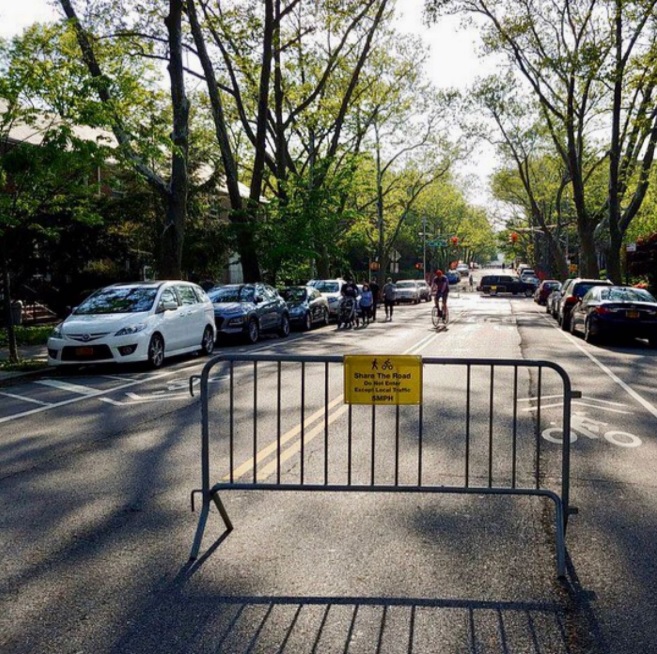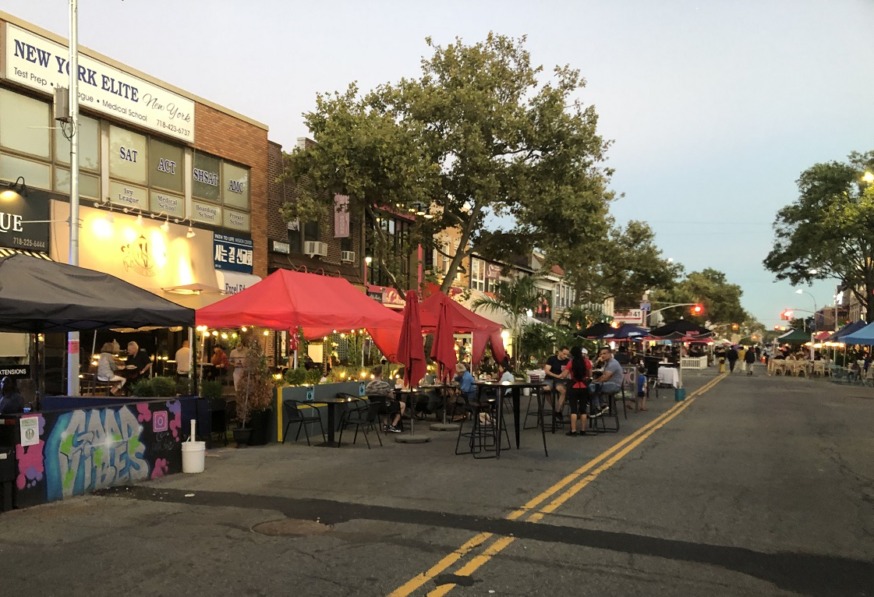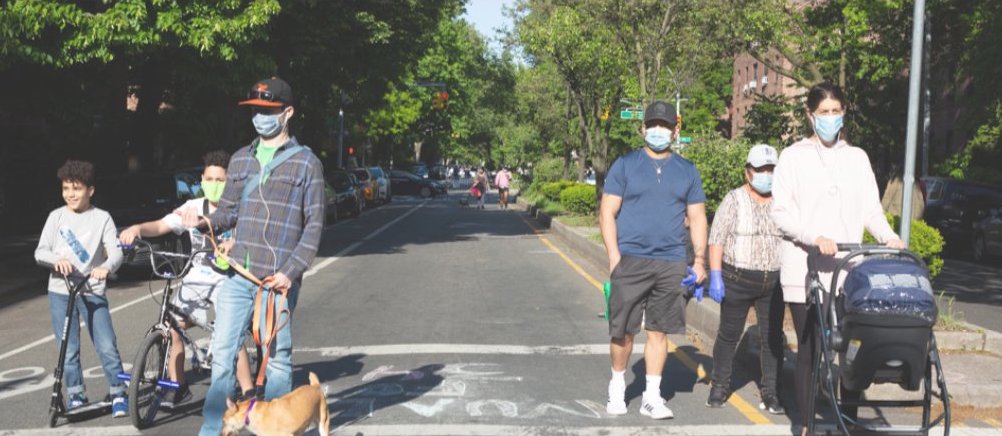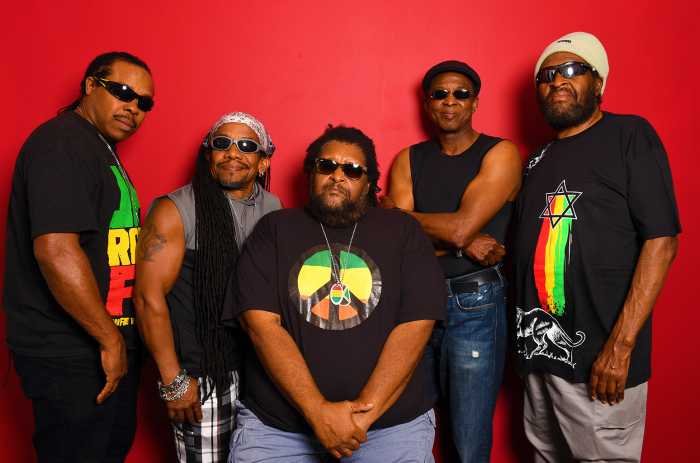
39th Avenue in Sunnyside, is an Open Street closed to vehicles daily from 8 a.m. to 8 p.m. except for local traffic and deliveries. Drivers are not permitted to go more than 5 mph along the stretch (Photo: Instagram @Sunnysideopenstreets)
March 29, 2021 By Allie Griffin
The New York City Department of Transportation (DOT) is now accepting applications for the second year of its Open Streets program that transforms roadways into pedestrian spaces and outdoor dining areas.
Local businesses and community groups can apply online to designate a street near them as an Open Street. Both new and existing community partners are encouraged to submit a 2021 application as soon as possible, although the DOT is accepting submissions on an ongoing basis.
Mayor Bill de Blasio announced Thursday that the application period for this year’s program has opened and the city will provide more support for community groups that manage Open Streets.
The program — which was launched last year to both help struggling restaurants when indoor dining was forbidden and give New Yorkers more outdoor space to enjoy while social distancing — will come with a number of improvements.
“With better signage, new barriers, and more support for community partners, this program will be sustainable for the long term – and better position New York City to break free of car culture and build a recovery for all of us,” de Blasio said.
The Open Streets program was enthusiastically embraced by restaurant owners, cycling advocates and local residents last year. It was set to expire at the end of October, but the DOT decided to continue it indefinitely.
“Last year, New York City seized an unprecedented crisis to totally reimagine our city streets,” Mayor Bill de Blasio said. “Open Streets was a runaway success – and now, I’m proud to deliver the framework we need to make it permanent.”

A stretch of Bell Boulevard in Bayside was closed for outdoor dining on weekend nights last year as part of the Open Streets program (Photo: Queens Post)
The program proved popular to Queens residents and restaurant owners last year. There are nearly 50 Open Streets across the borough where through traffic is blocked in favor of cyclist, pedestrian and restaurant usage.
“With the pandemic interrupting our normal way of life, Open Streets became salvations for restaurants and changed the way we dine here in New York City,” Queens Borough President Donovan Richards said in a statement. “Open Streets have truly revitalized boulevards, avenues and more across Queens, and I look forward to seeing our streets enjoyed again this year.”
Some Open Streets in Queens include 34th Avenue, from 69th Street to Junction Boulevard in Jackson Heights; 32nd Street, from 30th Avenue to Newtown Avenue in Astoria; 39th Avenue, from 45th Street to 50th Street in Sunnyside; 66th Road, from 110th Street to Grand Central Parkway in Forest Hills; Court Square West, from Jackson Avenue to dead end in Long Island City; Onderdonk Avenue, from Starr Street to DeKalb Avenue in Ridgewood and Peck Avenue, from 137th Street to Main Street in Flushing.
Many have called 34th Avenue in Jackson Heights — where residents have organized salsa classes, family bike rides, community gardening, art programming and more — as the crowning achievement of the program.
“Open Streets has given us the open space we sorely lacked in Jackson Heights, a community among those with the least amount of park space,” a spokesperson for the 34th Ave Open Streets Coalition said in a statement.
“We have exchanged pollution, noise and injuries for fresh air, tranquility, and safety, and have been thoroughly transformed by a permanent 34 Avenue Open Street.”

34th Avenue Open Street (DOT)
Meanwhile, Ditmars Boulevard — from 33rd Street to 36th Street — is one of many streets across the city that have been made into outdoor dining plazas. Restaurants along the strip can set up tables and chairs in the blocked-off roadway to serve customers outdoors during designated hours.
Other Queens Open Street locations and hours for each can be found on the DOT website.
Interested groups can apply for one of two types of Open Streets — temporary limited local access or temporary full closure.
The first designates a street for pedestrian and cyclist use during a specified set of hours and days each week (typically 8 a.m. to 8 p.m. seven days a week) and only allows car access for local loading, deliveries and parking — at 5 MPH.
The latter — which is formerly known as Open Streets: Restaurants — closes streets off to car traffic completely along business or restaurant corridors during set hours. Restaurants and other businesses can use these streets for outdoor seating and storefronts.
Applicants for Open Streets must agree to help manage the roadway they propose.
Such duties include setting up and breaking down street barricades; coordinating programming on the street; notifying the local community and stakeholders about the Open Street hours; and assisting restaurants and other businesses with Open Streets certification where applicable.
2 Comments







39th Ave in Sunnyside closure is underutilized and the barricades are a hazard for drivers and others alike! 5 mph signs would be enough to get the message across without inconveniencing fire trucks, delivery trucks, and other local drivers.
This is not a solution, but rather a hindrance for food delivery services, first responders, medical supply services, i.e. oxygen tank deliveries, laundry services, etc. who have to physically move the barriers to reach customers in a timely manner. There is plenty of sidewalk space for people to pass each other.